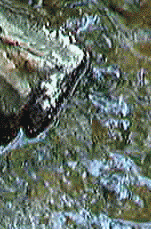Karman's vortex street
The Kármán vortex street is a phenomenon in fluid mechanics in which opposing vortices form behind a body in the flow . The vortex streets were first identified and calculated by Theodore von Kármán in 1911.
Henri Bénard carried out experiments on this as early as 1908.
Vortex formation

The nature of the vortex formation is essentially determined by the Reynolds number Re . It represents the ratio of inertia to viscosity forces and is calculated from the flow velocity, the diameter of the body and the viscosity . In the simplest case, that of a stationary cylinder in a steady flow, different configurations of the vortex street can be observed on the basis of the Reynolds number: At very low speeds or very high viscosities ( Re <4, e.g. in honey ) occurs at all no flow separation takes place. This case is a classic application of potential theory . With increasing speed, two counter-rotating vortex bubbles form on the side facing away from the flow, which become increasingly unstable from Re ≥30 and only then begin to show the typical, periodic pendulum motion. The frequency of the vortex shedding is characterized by the Strouhal number . The entire vortex street remains completely laminar up to Re <200 . In the area of higher Reynolds numbers, a distinction is made between where in the flow field the transition from laminar to turbulent flow occurs. This initially takes place in the distant wake ( Re ≈200) and, as the Reynolds number increases, it moves up to the boundary layer directly on the body. In this range of Re crit ≈10 4 the flow resistance of the body is minimal. Even in areas of very high Reynolds numbers ( Re > 5⋅10 6 ), such as those that occur with wind currents around television towers or islands, Kármán vortex streets can still be observed. The Strouhal number changes only insignificantly and reaches values up to a maximum of 0.30.
Examples
Eddy currents and vortex streets are a common phenomenon. However, it is not easy to observe them. Air currents cannot be easily recognized. Eddies of water are just as translucent as water itself. If you look closely, you will discover them in the bathtub if you run your finger through the water. If a liquid of high viscosity is added, e.g. B. a water-glycerine mixture, sometimes with food coloring, the colored threads show the direction of rotation.
The animation (right) shows how eddies form on an obstacle, how they flow with the current and how they rotate towards the obstacle.
Kármán vortex straits, for example, can form behind archipelagos that jut high out of the sea . The turbulence can then be seen on aerial photos as huge cloud structures, see the satellite photo on the right.
Behind a stick of incense swiftly moved through the air by hand , a Kármán vortex street similar to the picture above right can be observed.
Other examples are the whistling of overhead lines in strong winds or the sound of a swinging whip .
Peel frequency
The frequency of the vortices shedding can be determined by the Strouhal number. The following applies:
- ,
where stands for the flow velocity and for a characteristic dimension of the body around the flow. The Strouhal number depends on the shape of the body and the Reynolds number. For cylindrical bodies it is 0.18-0.22 for a wide range of Reynolds numbers. This is where voting takes place. The diameter is used here as the characteristic dimension. Thus, a 4 mm thick radio antenna on the roof of a vehicle traveling at 25 m / s (90 km / h) generates a clearly audible tone with the frequency
- .
Due to the linear relationship between the separation frequency and the flow velocity, the physical effect is used for flow measurement (“ vortex flow meter ”) with non-abrasive (see: wear ), low-viscosity media.
Resonance case
If the separation frequency of the vortices corresponds to the natural frequency of the body in the flow, it is set into oscillation . A well-known example are Aeolian harps . With regard to the alleged causes of the collapse of the first Tacoma Narrows Bridge on November 7, 1940, which had started to vibrate violently, it is discussed that it was not or not only due to the effect of a Kármán vortex street, but was the result of an aeroelastic flutter.
literature
- MM Zdravkovich: Flow around circular cylinders, Vol. 1: Fundamentals . 1st edition. Oxford University Press, 1997, ISBN 0-19-856396-5 .
- Thomas Kautzky: Structural investigation of the Kármán vortex street , dissertation, Technical University of Munich 1997.
See also
- Aeroacoustics
- Teslav valve with a similar swirl
- Coanda effect
Web links
- Various Views of from Karman Vortices gsfc.nasa.gov
- From Karman Vortices off Chile earthobservatory.nasa.gov
- Video: Experiment of the week: what is a vortex street? . Leibniz University Hannover 2011, made available by the Technical Information Library (TIB), doi : 10.5446 / 449 .
- Video: Karman's vortex street . Institute for Scientific Film (IWF) 2007, made available by the Technical Information Library (TIB), doi : 10.3203 / IWF / C-13098 .










